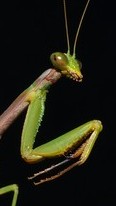 Mantids, also known as praying mantises, are a group of insects that include about twenty different species in North America where they live grasselands, meadows shrublands, and gardens . The most common are two introduced species, the European mantid (Mantis religiosa), the Chinese mantid (Tenodera sinensis), and the native Carolina mantid ((Stagmomantis Carolina). Mantids range in size from 3/8 to 5 7/8 inches and are usually green or brown providing good camouflage. They have an elongated thorax, and a triangular head with two large compound eyes on each side and long slender antennae,. Unlike other insects their heads can turn 180 degrees in either direction. The elongated fore legs are held in a praying position but are equipped with spike-like structures for grasping and holding their prey. The hind legs are adapted for standing, walking and jumping. Young mantids are nymphs and resemble adults but are smaller.
Mantids, also known as praying mantises, are a group of insects that include about twenty different species in North America where they live grasselands, meadows shrublands, and gardens . The most common are two introduced species, the European mantid (Mantis religiosa), the Chinese mantid (Tenodera sinensis), and the native Carolina mantid ((Stagmomantis Carolina). Mantids range in size from 3/8 to 5 7/8 inches and are usually green or brown providing good camouflage. They have an elongated thorax, and a triangular head with two large compound eyes on each side and long slender antennae,. Unlike other insects their heads can turn 180 degrees in either direction. The elongated fore legs are held in a praying position but are equipped with spike-like structures for grasping and holding their prey. The hind legs are adapted for standing, walking and jumping. Young mantids are nymphs and resemble adults but are smaller.
Mantids are voracious ambush predators both as adults and nymphs. The are generalists and eat any insect they can catch including aphids, mites, crickets, ants, small wasps, true bugs, grasshoppers, leafhoppers, cockroaches, mosquitoes, flies, beetles, bees, spiders, butterflies, moths, and caterpillars. Large species eat frogs, lizards, and small birds including hummingbirds. When other food sources are lacking they turn to cannabalism and this tendency together with their inclination to eat other beneficial fauna like ladybugs and hummingbirds has limited their use for pest management. Some experts in fact are warning against the use of mantids for insect control.
In autumn females lay eggs on twigs or stems in large oval masses protected with a foamy substance that hardens and protects the eggs from predation. The eggs overwinter and hatch in the spring. The nymphs immediately begin to eat smaller insects including each other and go through several molts until they reach adult size.
In order to attract and maintain a population of mantids, both food and cover must be available so they can complete their life cycle. Tall grasses, shrubs, and herbaceous plants can provide cover and protection but since eggs overwinter on twigs and stems, vegetation should be allowed to stand until spring. Although mantids are primarily predatory and do not use flowers as a food source, planting diverse plant material will attract a wide variety of insects to feed them and hopefully reduce cannabalism. Finally, avoid the use of insecticides.